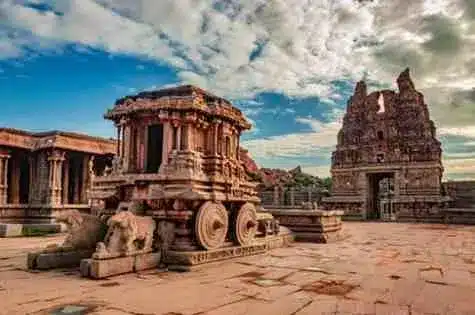In the heart of Karnataka, nestled among surreal boulder-strewn landscapes and echoing ruins, lies Hampi—a place where history whispers through stones and the soul feels the weight of forgotten glory. Once the magnificent capital of the Vijayanagara Empire, Hampi is not just an archaeological site—it is a living chronicle of India’s cultural and historical splendor.
A City Born of Legends
The origins of Hampi are deeply entwined with myth and legend. According to Hindu mythology, Hampi is believed to be Kishkindha, the monkey kingdom mentioned in the Ramayana, where Lord Rama met Hanuman and Sugriva during his quest to rescue Sita. The ancient name of Hampi was Pampa Kshetra, named after the goddess Pampa, a form of Parvati. She is said to have meditated on the banks of the Tungabhadra River, which still flows beside the ruins today, carrying with it the echoes of a divine past.
Rise of the Vijayanagara Empire
The real historical journey of Hampi began in the early 14th century, when it rose from the ashes of plundered southern kingdoms. In 1336 CE, Harihara I and Bukka Raya I, two brothers and former commanders of the Hoysala Empire, established the Vijayanagara Empire with Hampi as its capital.
Their dream? To build a Hindu bastion against the advancing Delhi Sultanate. What followed was nothing short of extraordinary. Under the visionary rule of Krishnadevaraya and his successors, Hampi blossomed into one of the largest and wealthiest cities in the world, attracting traders, artists, poets, and warriors from far-off lands.
Architectural Brilliance
Walking through Hampi is like stepping into a time capsule. The grandeur of Vittala Temple, with its iconic stone chariot and musical pillars, showcases the aesthetic brilliance of Dravidian architecture. The Virupaksha Temple, still in use today, dates back to the 7th century and stands as a beacon of unbroken spiritual tradition.
Other monuments like the Lotus Mahal, Queen’s Bath, Hazara Rama Temple, and Elephant Stables reflect a blend of religious, royal, and everyday life of the empire. Even in their ruin, these structures exude a dignified silence, as if mourning a time when the city thrummed with life.
A Prosperous Cosmopolitan Hub
Historical records from Persian, Portuguese, and Chinese travelers describe Hampi as a bustling metropolis, teeming with bazaars, jewel markets, towering gopurams, and an incomparable richness in art and culture. Foreign visitors were awe-struck by the prosperity, discipline, and infrastructure of the empire. At its height, Hampi was second only to Beijing in size.
This wasn’t just a place of warriors—it was a city of poets, philosophers, dancers, and dreamers, nurtured under a dynasty that cherished education, trade, and spirituality.
The Fall: A Tragedy Engraved in Stone
In 1565, the city met its heart-wrenching downfall after the Battle of Talikota. A coalition of Deccan Sultanates defeated the Vijayanagara army. What followed was a brutal destruction that lasted for months—temples desecrated, palaces burned, and markets turned to ash. A city that once symbolized resilience and divinity was left a haunting shadow of its former self.
The pain of Hampi’s fall still lingers. For anyone who walks its silent paths, it’s not just about ruins—it’s about grief, memory, and forgotten pride. Hampi wasn’t just destroyed—it was broken, and its story buried under centuries of silence.
Rediscovery and Revival
It wasn’t until the 19th century that Hampi began to emerge from the sands of time. British archaeologists and Indian historians began documenting and restoring parts of the site. Today, it is a UNESCO World Heritage Site, attracting historians, travelers, and spiritual seekers from around the globe.
Each year, the Hampi Utsav breathes life into the ruins, celebrating the glory of the empire with music, dance, drama, and processions—a modern tribute to a timeless culture.
Why Hampi Still Matters
In a world obsessed with skyscrapers and digital marvels, Hampi stands as a reminder of what we once were and what we can still become. It reminds us of the transience of power, the importance of cultural identity, and the unbreakable spirit of human creativity.
Hampi is more than just stones—it is emotion carved in granite, a testament of love, and a warning of loss. It teaches us that civilizations, no matter how grand, are fragile. But their stories endure, and in those stories, we find our roots, our inspiration, and our truth.
Final Thoughts
To visit Hampi is to feel history—not just see it. It’s a journey through time, a symphony of silence and song, of devastation and rebirth. Whether you’re a traveler, historian, photographer, or seeker of peace, Hampi calls out with an intensity that is hard to ignore.
So next time you seek not just a destination but a soulful experience, listen to the voice of the ruins. They’re not just speaking—they’re crying, singing, and remembering.—

